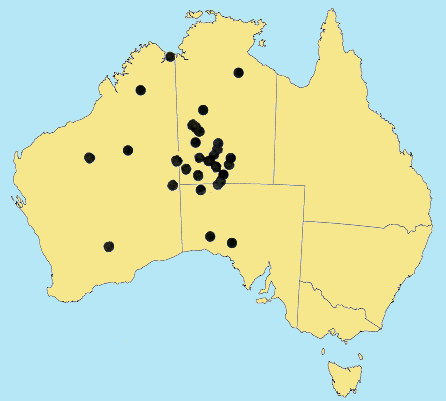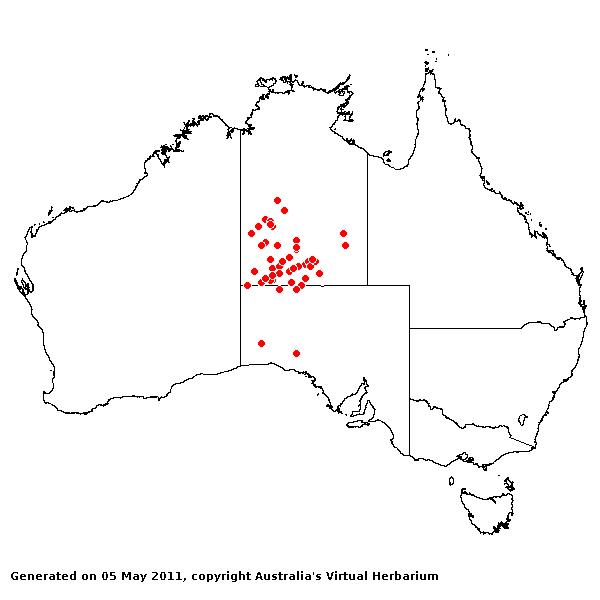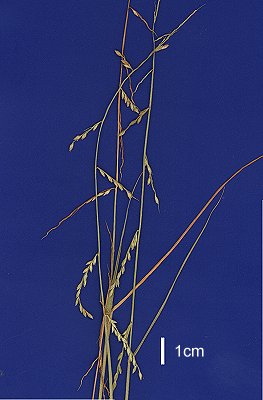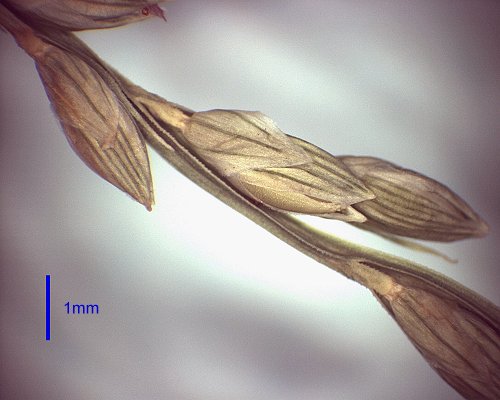Paspalidium reflexum R.D. Webster. Paniceae Austral. 166 (1987).
Classification. (GPWG 2001) : Subfamily Panicoideae. Paniceae.
Type of Basionym or
Protologue Information: HT: Latz 4847, Australia (NT).
Key references
(books and floras): [2002] D.Sharp & B.K.Simon, AusGrass, Grasses of
Australia, [2006] J.Jessop, G.R.M.Dashorst, F.M.James, Grasses of South
Australia (484 as Setaria reflexa).
Illustrations:
[2006] J.Jessop, G.R.M.Dashorst, F.M.James, Grasses of South Australia (484, fig. 418 as Setaria).
Habit. Annual.
Rhizomes absent. Culms erect, 20–55 cm tall, 2–5 -noded. Mid-culm internodes
hollow. Mid-culm nodes glabrous. Lateral branches sparsely branched.
Leaf-sheaths smooth, glabrous on surface. Ligule an eciliate membrane or a
fringed membrane, 0.6–0.9 mm long, truncate. Leaf-blades 8–26 cm long, 2–4.5 mm
wide. Leaf-blade surface smooth, glabrous.
Inflorescence.
Inflorescence compound, a panicle of racemes. Racemes 3–10, deflexed, 2–6 cm
long, 2–3 mm wide, bearing 8–20 fertile spikelets on each. Central
inflorescence axis 10–18 cm long.
Spikelets.
Spikelets pedicelled. Fertile spikelets 2-flowered, the lower floret barren
(rarely male), the upper fertile, comprising 1 basal sterile florets,
comprising 1 fertile floret(s), without rachilla extension, elliptic, dorsally
compressed, 2.6–3.3 mm long.
Glumes.
Glumes thinner than fertile lemma. Lower glume ovate, membranous, without
keels, 3 -nerved. Lower glume surface glabrous. Lower glume apex muticous.
Upper glume elliptic, 2.6–3.3 mm long, membranous, without keels, 9–11 -nerved.
Florets. Basal sterile florets 1, barren, without significant palea.
Lemma of lower sterile floret 100 % of length of spikelet, membranous, 7
-nerved. Fertile florets bisexual.
Fertile lemma 2.5–3.2
mm long, without keel. Lemma apex mucronate. Anthers 3.
Continental
Distribution: Australasia.
Australian
Distribution: Western Australia, Northern Territory, South Australia.
Western Australia:
Canning, Giles. Northern Territory: Central Australia North, Central
Australia South. South Australia: North-western, Nullabor,
Gairdner-Torrens Basin.
Notes.
Gross morphological features of this species resemble those of Parectenium,
however, mode of disarticulation and nervation of glumes and lemma excludes it
from this genus.
In shrub steppe
shrublands, acacia shrublands, arid tussock grasslands, and arid hummock
grasslands. Flowers year-long, but mostly Apr.-Sept.






